“禁忌”的魅力,就好像来自那不勒斯海的塞壬天籁般的歌声,又如伊甸园里让人垂涎欲滴的智慧果,危险却也诱人,所以有人为追随塞壬的歌声宁愿永沉大海,亚当与夏娃一尝禁果后被逐出伊甸园。同理,人们对“黑暗世界”的窥探与研究正是因为其散发的“可怕”甚至“不道德”的光芒。人们对“罪犯的艺术”的追捧,除却“对边缘群体的关怀”这层荣光,更多还是对那个“黑暗的角落”一种“欲尝又止”的窥探心理在作怪。——Mac
文字难度:★★★☆
The art world often nurtures its 1)enfants terribles. After all, rule breakers sell paintings. So it’s no surprise that real 2)felons are increasingly winning notice on the scene. As therapeutic art programs 3)burgeon behind bars, “criminal art” has generated a curious 4)niche in the U.K. London’s prestigious Southbank Centre will turn over its gallery space to works by Britain’s 5)inmates. The show, Art by Offenders (Oct. 21–Dec. 3), is organized by the Koestler Trust, a charity that awards convicts with small cash prizes and a cut of any work sold. The show will be 6)curated by female prisoners on special supervised release who will give tours of the exhibit to the public.


In some pieces, the 7)claustrophobia of prison life is 8)palpable; an anonymous painting titled Full House shows a crowded mass of uniformed figures, representing Britain’s swelling prison population. In a work called 9)Vortex, one of the potential exhibits in London, a 10)futuristic swirl of color is 11)splattered with red, blood-like paint. Another piece, entitled My World in Winter, is an abstract 12)Peter Doig-style picture that evokes the 13)gritty texture of the prison yard.
Therapeutic art programs are widely believed to help 14)rehabilitate criminals. Now they’re also generating controversial interest from critics and private collectors. Earlier this year, two paintings by London’s notorious Kray twins—who ran a violent gang called “the Firm” during the 1960s, were convicted of murder, and have since died—15)netted nearly £1,000 16)apiece when they went 17)under the hammer at a London auction house. “(People) imagine that the 18)underworld might be revealed by having access to this work,” says Walsh. “Suddenly the taboo life of people in prison is available to the public. Even if it’s not to fully understand (it), it’s just an attempt to try and glimpse that world. That desire is very compelling. That’s what’s driving this market.”
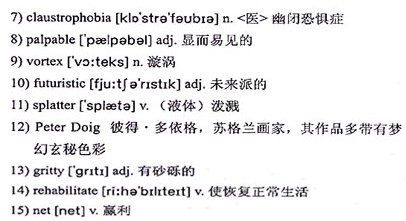
艺术界往往是培育“坏孩子”的温床,毕竟,敢于破规犯戒的人才能使其艺术作品有卖点。所以,难怪重刑犯在这方面的发展愈发受到关注。随着艺术治疗项目在狱中“生根发芽”,“罪犯的艺术”在英国创出了一片奇特的小天地。伦敦颇负盛名的南岸中心画廊将腾出场地展示英国犯人的艺术作品。10月21日至12月3日的“囚犯创艺展”由凯斯特勒信托基金会主办,该基金会是一家慈善机构,向罪犯发放小额奖金以及售卖作品所得的部分款项。展览将由获短期假释的女犯人组织管理,亦由她们负责向来参观的公众作导览讲解。
在一些作品当中,牢狱生活引发的幽闭恐惧症是显而易见的;一幅没有署名,题为《满座》的作品画的就是一群穿着统一的囚服挤在一块的人,这表现了英国监狱的人数膨胀得很厉害。在一幅名为《漩涡》的作品中(可能会在伦敦展出),充满未来感的回旋色彩上被泼溅了血一般的红色颜料。另外一幅名为《我冬天的世界》的作品是一幅彼得·多依格风格的抽象画,使人联想起监狱院子那泥地沙砾的质感。 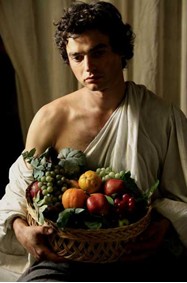 人们普遍相信艺术治疗项目可以帮助罪犯改过自新。现在,这些项目还引起了评论家和私人收藏家的兴趣,个中争议重重。今年早些时候,伦敦臭名昭著的克莱双胞胎兄弟的两幅画在伦敦一家拍卖行拍卖,每幅差不多净赚1000英镑。这两人在上个世纪六十年代操办一个名叫“合伙”的暴力帮会,后来被裁定谋杀罪成立,之后就死了。“(人们)设想要是看到这幅作品,便能一窥黑社会的内幕,”沃尔什说,“突然间,狱中犯人如禁忌般的生活可以向公众敞开了。即便还不能彻底了解(它),但起码也是尝试和窥探这个世界的一步。这一欲求非同小可,是带动这个市场的主导力量。”
人们普遍相信艺术治疗项目可以帮助罪犯改过自新。现在,这些项目还引起了评论家和私人收藏家的兴趣,个中争议重重。今年早些时候,伦敦臭名昭著的克莱双胞胎兄弟的两幅画在伦敦一家拍卖行拍卖,每幅差不多净赚1000英镑。这两人在上个世纪六十年代操办一个名叫“合伙”的暴力帮会,后来被裁定谋杀罪成立,之后就死了。“(人们)设想要是看到这幅作品,便能一窥黑社会的内幕,”沃尔什说,“突然间,狱中犯人如禁忌般的生活可以向公众敞开了。即便还不能彻底了解(它),但起码也是尝试和窥探这个世界的一步。这一欲求非同小可,是带动这个市场的主导力量。”
The growing demand has sparked a 19)contentious ethics debate in the U.K. Should convicted murderers be allowed to use government funds to become professional artists while they serve life sentences? To be sure, censoring the work of murderers would 20)discount several of history’s most talented artists—including 21)Caravaggio, who killed a man in a 22)brawl in 1606. Tim Robertson, director of the Koestler Trust, believes convicts should be encouraged to exhibit art made during their 23)incarceration. “On the whole, it’s to the benefit of all of us that the work is exhibited,” he says. “It is a way of rebuilding (a prisoner’s) relationship with society. Some of these prisoners are creating amazingly skilled work. By exhibiting it, you get to hear their perspectives. The majority of the public have no idea what’s happening (inside prisons). They are grim places. My God, they’re grim.” Opponents argue that displaying and selling criminal art celebrates some of society’s most violent 24)sociopaths.
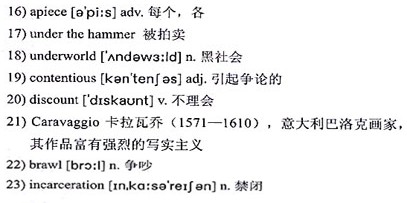
Some serious offenders have established popular followings. One British 25)detainee, Michael Gordon Peterson, who has assumed for himself the name of tough-guy actor 26)Charles Bronson, is the subject of a recent 27)biopic, and is a 28)prolific artist with more than a dozen Koestler awards. Bronson was convicted of armed robbery in 1975, then staged a one-man protest by taking hostages and assaulting guards. The former fighter has been in solitary confinement for the past 30 years and received a life sentence while in jail after he took his art teacher hostage in 2000. Yet his colorful, often comic cartoons depicting his 29)precarious state of mind continue to attract buyers online. This summer, the Welsh charity the Beacon of Hope sold two of his works for more than £700 after Bronson donated them to the trust. The charity is quick to point out Bronson’s good intentions as a clear sign that a once violent man is changing his ways.
So-called outsider art has been fashionable for some time, but the question of profit is clearly troubling the government, which is currently reviewing a section of the 30)Coroners-and-Justice Bill to empower the courts to seize assets from offenders who have made money from their crimes. A Ministry of Justice spokesman stated that criminals should not be allowed to “cash in on the story of their crime.”
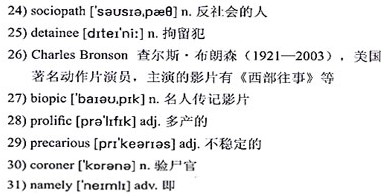
But prison art appears to adhere to the same principles as all commercially driven art: 31)namely, market forces 32)trump all. And there’s clearly a consumer demand for criminal art. Ronnie Kray’s 33)Munch-like landscapes with 34)menacing figures standing outside bleak buildings sold in spite—or perhaps because—of his conviction for murder, 35)racketeering, and torture. What’s more, the auction was a spectacle, attracting serious 36)aficionados as well as 37)ne’er-do-wells from the Krays’ 38)sketchy past. “Some of the crowd you were afraid to speak to; others were collectors,” says Paul Smith of the Hampshire auction house. “It didn’t matter that the work wasn’t any good. There was a 39)morbid fascination all round.” As admirers of artists from Francis Bacon to Edvard Munch can attest, few things are more alluring than the vision of a dark mind hanging on the wall.
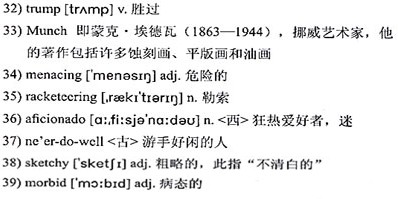
对囚犯画作追捧不已的风气在英国引发了一场激烈的道德论战。应该让被判无期徒刑的杀人犯利用政府资金变身为职业艺术家吗?诚然,如果真要对杀人犯的作品审查设限,那必将忽视了历史上多位最具才华的画家——包括1606年在一次争吵中杀了一个人的卡拉瓦乔。凯斯特勒信托基金会主任提姆·罗伯逊认为,应该鼓励罪犯展出其在狱中创作的作品。“总的来讲,展出作品对我们大家都有好处,”他说,“这是(一个犯人)重新与社会建立联系的一个途径。一些犯人创作的作品所展现的画工之纯熟令人赞叹。通过展览这些作品,你可以倾听了解他们的观点。绝大部分公众对(狱中)生活没有什么概念。那可真是可怕的地方,天啊,太可怕了。”反对者则争辩说,展览和销售罪犯的艺术作品等于是在颂扬一群暴力至极的反社会人士。
一些重刑犯竟有了众多追随者。英国一个刑拘犯迈克尔·戈登·彼得森假借了硬汉形象演员查尔斯·布朗森的名字进行犯罪并成为最近一部传记影片的主角,他还是一个多产的艺术家,获得了十几项凯斯特勒奖。布朗森于1975年因持械抢劫被定罪,之后他劫持人质、攻击狱警,上演了一场抗议示威的独角戏。此前抗争不断的他被单独监禁了30年,后因2000年在狱中劫持他的美术老师做人质而被判终身监禁。然而,他那些色彩丰富且往往描画自己多变心态的漫画作品在网上不断吸引到买家。今年夏天,威尔士的一家慈善机构“希望之光”把布朗森捐赠的两幅画以超过700英镑的价格售出。该机构旋即指出,布朗森的善意清楚地表明一个过去喜欢诉诸暴力的人正在改变自己的行为方式。
所谓的“圈外人艺术”已流行好一段时间了,但是利润问题显然困扰着政府。政府目前正在复议《验尸官司法法案》中的一项条款——授权法庭有权没收罪犯通过犯罪赚来的财产。司法部的一名发言人称,不应该允许犯人“以其犯罪经历来套取利益。”
但是监狱艺术似乎跟所有受商业利益驱动的艺术一样遵循着同样的法则,即市场力量高于一切。显然,消费者对“罪犯的艺术”有需求。尽管罗尼·克雷犯了谋杀、诈骗和虐待罪——或许正因为他犯了这些罪——他那些蒙克式的风景画——荒凉的建筑物外站些令人望而生畏的人物——才能够卖得出去。不仅如此,拍卖会的场面更是壮观,被吸引的除了真正的艺术狂热分子之外,还有克雷那些在过去犯罪日子结交下来的狐朋狗党。“人群中有些人你根本不敢跟他说话,剩下的就是一些收藏爱好者。”汉普郡拍卖行的保罗·史密斯说,“作品很拙劣也不要紧。周围弥漫着一种病态的狂热。”从弗朗西斯·培根到埃德瓦·蒙克,众多的艺术追随者都能证明,没有什么比看到一颗悬挂在墙上的黑暗心灵更吸引人的了。
